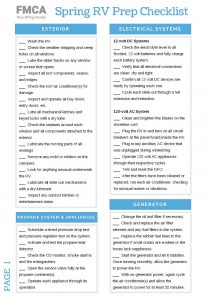
 Many RVers are antsy for the first trip of the season. Winter has ended, and spring is in the air. It’s time for trees to blossom, the birds to chirp and the campgrounds to open!
Many RVers are antsy for the first trip of the season. Winter has ended, and spring is in the air. It’s time for trees to blossom, the birds to chirp and the campgrounds to open!
You likely readied your RV last fall for storage; you may have even fully winterized your RV for colder temperatures. After each period of non-use, regardless if the RV was simply parked in the driveway or winterized for sub-freezing temperatures, every RV must be properly prepped before taking off down the highway. Many call this preparation process the “spring shakedown” or “dewinterizing.” It involves a few detailed tasks, best addressed in a systematic manner.
The following procedures are presented in an order that assures nothing will be forgotten. Not all steps may be relevant to your specific RV.
Wishing you had a list to easily mark as you work through these steps? FMCA has you covered!
Download now: Spring RV Prep Checklist
RV Exterior
- A clean RV will better reveal discrepancies than a dirty one, so begin by washing the RV. Wax and polish the exterior if necessary.
- Check the weather-stripping and the weep holes on all windows, ensuring they are not clogged. Lube the slider tracks on any window or screen that opens.
- Inspect all roof components, seams, and edges. Now is the time to seal any areas that need attention.
- Check the roof air conditioner(s) for damage. Clean or replace the return air filters.
- Inspect and operate all bay doors, entry doors, etc. Lube all mechanical latches and keyed locks with a dry lube.
- Check the sealants around each window and all components attached to the exterior sides of the RV. Reseal if necessary.
- Lubricate the moving parts of all awnings. Remove any mold or mildew on the canopies.
- Look for anything out of the ordinary underneath the RV.
- Lubricate all slide-out mechanisms using a dry lubricant.
- Inspect any outdoor kitchen or entertainment areas.
Electrical Systems
12-volt DC Systems
- Check the electrolyte level in all flooded, 12-volt batteries and fully charge each battery system. Always provide batteries the advantage of having a complete charge at the start of any camping season.
- Verify that all electrical connections are clean, dry and tight. Confirm all 12-volt DC devices are ready by operating each one. Turn on all lights, fans, etc.
- Cycle each slide-out through a full extension and retraction several times while listening and watching for binding or abnormal noises.
120-volt AC System
- Clean and brighten the blades on the shoreline cord.
Note: Always measure the source voltage and check the polarity of incoming AC power before plugging in. The voltage must stay steady between 103 and 125-volts AC. - Plug the RV in and turn on all circuit breakers at the panel board inside the RV.
- Plug in any ancillary AC device that was unplugged during the winterizing process.
- Operate 120-volt AC appliances through their respective cycles.
Note: Be sure the absorption refrigerator is properly leveled prior to operating it on electric. - Test and reset the GFCI (ground fault circuit interrupter)
- After the filters have been cleaned or replaced, run each air conditioner, checking for unusual noises or vibrations.
Plumbing Systems
Fresh Water
- If employed last fall, drain the RV anti-freeze from the fresh water system.
- Fill the fresh water tank about half full.
- Remove the water heater from by-pass. If the water heater is a Suburban model, remove and inspect the anode rod. Replace it if it is 75% depleted.
- Turn the water pump on and begin flushing out all water lines. Open each faucet to eliminate any residual RV anti-freeze. Don’t forget the exterior showerhead, the icemaker or the clothes washer, if so equipped.
- At the water heater, open the pressure and temperature relief valve. Once water begins gushing from the P&T valve, close the lever.
- Once water is flowing smoothly from each faucet, shut them all off.
- Flush the toilet a couple of times to fill its internal tubing.
- Turn off the water pump, and then open the water heater P&T relief valve once more. Leave it open until water stops dripping from the outlet, and then close it. This establishes the necessary expansion space on top of the water inside the heater tank.
- Attach the fresh water hose to the city connection and verify that all freshwater components operate properly. Inspect for water dripping or seeping anywhere, inside and outside the RV.
- Finally, chlorinate the entire fresh water system.
Waste Systems
- Flush and drain each holding tank completely.
- Disassemble and lubricate all termination valves. Ensure each one operates smoothly and fully closes.
- Inspect the sewer hose for pinholes or damaged seals.
Propane System & Appliances
- Contact a Certified or Master Certified RV service tech and schedule a timed pressure drop test and pressure regulator test on the propane system. Ensure the system is 100% leak-free prior to continuing prepping the propane system.
- Activate and test the propane leak detector. Also check the CO monitor, smoke alarms and fire extinguishers for proper readiness.
- Open the service valve fully at the propane container(s).
- Vacuum in and around all furnace ducts.
- Operate each appliance through its operation.
Note: Be sure the refrigerator is appropriately leveled prior to testing its operation on gas and that the water heater is full of water before initiating the propane sequence on it.
Generator
- Check the oil level. Change the oil and filter if necessary.
- Check and replace the air filter element and any fuel filters in the system, if so equipped.
- Check the condition of the rubber fuel line to the generator. If small cracks are evident or the hoses lack suppleness, replace them.
- Start the generator and allow it to stabilize. Once it is running smoothly, allow the generator to power the RV.
- With on-generator power, again cycle the air conditioner(s) and allow the generator to carry this load for at least 30 minutes.
Tires and Wheels
- Closely inspect all tires. Remove rocks or pebbles lodged in the tread.
- Examine all sidewalls. Never drive on tires showing any evidence of sidewall weather-checking.
- Examine the DOT date code.
Note: Tire replacement needs vary with RV usage. Tires approaching 5 to 7 years of age may need replacing. The last four digits of the DOT code indicate the week and year of manufacture. Example: 4010 indicates that tire was manufactured during the 40th week of 2010. - Clean and treat all tires with a non-petroleum based treatment.
- Be sure all tires are pressurized to the correct inflation as determined by your owner’s manual.
- Torque all lug nuts to the specified requirement.
Chassis
Motorhomes
- Check all fluid levels. Those typical to most gasoline-powered motorhomes include engine oil, transmission fluid, rear axle gear oil, power steering fluid, brake fluid, radiator coolant, windshield washer fluid, fuel tanks and hydraulic leveling system/slide-out reservoir.
- For diesel coaches, refer to the owner’s manual for the manufacturer’s recommendations for that chassis.
- Check the odometer; it may be time for a tune-up or brake inspection.
- Verify the integrity of engine drive belts and coolant hoses.
- Test all running lamps, turn signals, headlamps, etc., as well as antennas, entry steps and all accessories not mentioned specifically here.
- Take the motorhome on a short road test. Be aware of strange noises, vibrations, and abnormalities with steering and handling.
Towable RVs
- Every two years, clean and pack the wheel bearings and replace the seals.
- Adjust all electric brakes if necessary.
- Inspect all spring shackles, U-bolts and hitch components.
- Test the breakaway switch for proper operation.
- Test all running lamps, turn signals, stop lamps, etc., as well as antennas, entry steps and all accessories.
- Road test for proper brake modulation and handling. Take note of strange noises, vibrations, and abnormalities with steering and handling while towing.
The “spring shakedown” is also a great time to make sure your RV records are up-to-date. Read our post about RV record-keeping, and download FMCA’s handy RV Records template.
This information is for educational purposes. FMCA shall not be responsible nor retain liability for RVer’s use of the provided information. Prior to making any RV service decision, you are advised to consult with an RV professional.



I’m glad that you explain how RVs need to be properly prepped after a period of non-use and that you explain the different things to check, such as fluid levels and electric brakes. Proper maintenance could ensure your vehicle is safe to drive and it could also help it last longer. If you notice any issues, it would probably be a good idea to take your vehicle to an RV technician as soon as possible so that you can get it repaired quickly in order to avoid any problems.